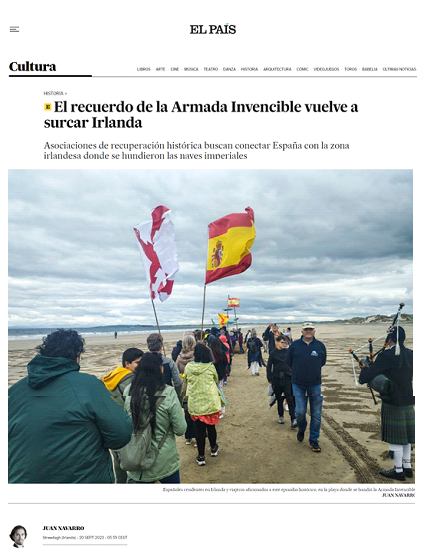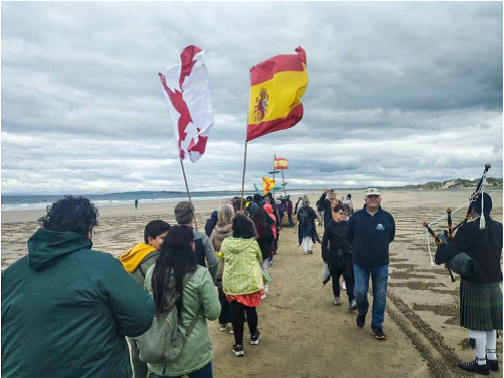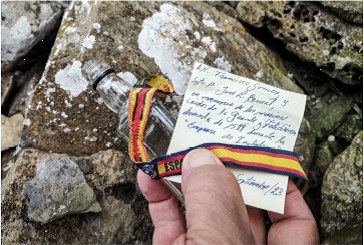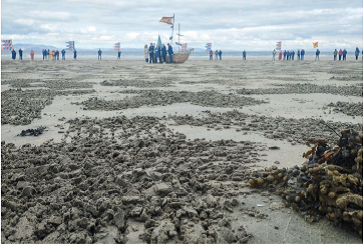Streedagh (IRELAND), September 20th 2023 (EL PAÍS) By Juan Navarro
Historical recovery associations seek to connect Spain with the Irish area where the imperial ships sank
A few drops of whiskey slip on the fallen rocks of the ruined Staad Abbey in Grange (Ireland). The waves hitting the rocks dented by centuries of storms break the silence of the ceremony. The small bottle, empty of that revitalizing ambrosia for generations of sailors, houses a small paper with blue ink letters and a bracelet with the flag of Spain. José Luis Bernal, a 65-year-old man from Cádiz and a retired naval soldier, is moved while hiding the treasure under the rubble of the old convent. For centuries, the surrounding beaches spat out the remains of three ships of the Spanish Invincible Armada, sunk there on September 23, 1588. The slaughter of the English army, allied with the Atlantic Ocean, forged a union between Spain and Ireland that has attracted to County Sligo to Spaniards, Irish and members of the current Navy determined to recover the historic alliance in defeat.
The sad fate of the 3,000 shipwrecked of the Great Armada of Philip II
The last standing wall of the abbey, in an unbeatable meadow for modern cows, was one of the first shelters that Captain Francisco de Cuéllar saw when he fled from the enemy. There he hoped to find help, but he found 12 of his men hanged. Some 1,100 soldiers died in those bays and De Cuéllar, revered by the natives even to call hamburgers or routes but almost unknown in his homeland, marked the beginning of a myth with his escape. The Spanish Armada Ireland, an association based in Sligo (20,000 inhabitants), has cared for this memory and recovered from the bottom of the sea cannons, weapons or remains of La Lavia, La Juliana and Santa María de Visón, three ships lying under those waters, whose legacy It is exhibited in Dublin.
A small paper with blue ink letters and a bracelet with the Spanish flag from José Luis Bernal, a 65-year-old Cadiz native and retired naval soldier
The tributes have seduced Spaniards living on the island or peninsular travelers who are fond of this historical episode, explains Eddie O’Gorman, 70 years old. The Irishman leads the local groups that this September have achieved the presence of the Spanish ambassador in the country, Ion De la Riva, and senior officials of the Navy to accompany the events in honor of these sailors. «With the 400th anniversary, in 1988, we began to work on more associations. We were surprised that in Spain Francisco de Cuéllar and what happened with the Navy was almost unknown, the exchange students end up fascinated because we know more than they do,» says O’ Gorman.
Streedagh beach serves as the setting for the initiative. Hundreds of crosses raked on the sand, one for each fallen Spaniard, surround a straw boat, bow to land, remembering those who could not dock.
little boat while those present, Españoles or Irish, place yellow and red flowers on the deck. It is not raining but the clouds and the wind illustrate the arduous task of getting there pursued by the English, an old common enemy of those attending.
Ambassador De la Riva, with one year of service, admits that he barely knew about this legacy until he took office. «We want this route to join other historical ones such as the Quetzal route of 1992, in reminder of the discovery of America, or Magellan’s circumnavigation of the world to make a shipwreck route in Ireland,» explains the Spanish representative. «Ireland is a very beloved country but nothing is known about it in Spain, there are common issues from the Celts to the IRA and ETA,» he says. This is evident in the taverns and pubs, full of smiles and broken Spanish in a homeland where for centuries Latin features existed between pale skin and red hair as evidence that some crew member did survive that massacre.
One of the beaches where the remains of three ships reached for centuries.
The vice admiral and director of the Naval Museum of Madrid, Enrique Torres, 61, feels «in historical debt to a key episode, we are grateful to Ireland for rescuing and honoring our memory, we should be the promoters.» 38 members of the Centinela patrol car have attended with him.
One of the national officials of this meeting, Carlos Burgos, has led a group of 12 attendees and diverse backgrounds united by the Navy. The president of the Hispano-Irish association, 57, has been promoting ties between both nations for years with actions such as searching in Valladolid for the remains of the Irish revolutionary Red Hugh O’Donnell, who arrived in 1602 in the then imperial capital to ask Philip III for help. against, of course, the English. «We want to promote relations between Spain and Ireland, history has brought us together since the Milesians and the first inhabitants of the island. We defend music, languages, art, literature,
The paraphernalia of Sligo, adorned by Spanish flags these days, amazes Cristina Montijano, 15, from Cordoba, a student this year in the area. «I had no idea about this, it’s a little sad that I don’t know about it and strange that it’s celebrated here and not in Spain. My grandmother had told me something about it, but it doesn’t sound familiar to me,» says the young woman amidst the wind of the fateful beach Dogs dig holes in the sand as the first broken flower petals fly over the bay. In a few hours, between the wind and the tide, they will erase the crosses as the memory of those they represent was erased for centuries.
Historians say O’Donnell’s skeleton will be easily identifiable since it is well documented that he lost toes to frostbite following his escape from Dublin Castle in 1591.










Post a comment